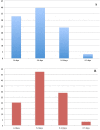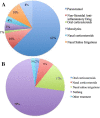Olfactory and gustatory dysfunctions as a clinical presentation of mild-to-moderate forms of the coronavirus disease (COVID-19): a multicenter European study - PubMed (original) (raw)
Multicenter Study
. 2020 Aug;277(8):2251-2261.
doi: 10.1007/s00405-020-05965-1. Epub 2020 Apr 6.
Jerome R Lechien 1 2 3 4, Daniele R De Siati 5 7, Mihaela Horoi 8, Serge D Le Bon 8, Alexandra Rodriguez 8, Didier Dequanter 8, Serge Blecic 9, Fahd El Afia 5 10, Lea Distinguin 5 10, Younes Chekkoury-Idrissi 5 10, Stéphane Hans 10, Irene Lopez Delgado 5 11, Christian Calvo-Henriquez 5 12, Philippe Lavigne 5 13, Chiara Falanga 5 14, Maria Rosaria Barillari 5 14, Giovanni Cammaroto 5 15, Mohamad Khalife 16, Pierre Leich 17, Christel Souchay 17, Camelia Rossi 18, Fabrice Journe 19, Julien Hsieh 5 20, Myriam Edjlali 21 22, Robert Carlier 22, Laurence Ris 23, Andrea Lovato 24, Cosimo De Filippis 24, Frederique Coppee 25, Nicolas Fakhry 5 26, Tareck Ayad 5 13, Sven Saussez 5 19 8 16
Affiliations
- PMID: 32253535
- PMCID: PMC7134551
- DOI: 10.1007/s00405-020-05965-1
Multicenter Study
Olfactory and gustatory dysfunctions as a clinical presentation of mild-to-moderate forms of the coronavirus disease (COVID-19): a multicenter European study
Jerome R Lechien et al. Eur Arch Otorhinolaryngol. 2020 Aug.
Abstract
Objective: To investigate the occurrence of olfactory and gustatory dysfunctions in patients with laboratory-confirmed COVID-19 infection.
Methods: Patients with laboratory-confirmed COVID-19 infection were recruited from 12 European hospitals. The following epidemiological and clinical outcomes have been studied: age, sex, ethnicity, comorbidities, and general and otolaryngological symptoms. Patients completed olfactory and gustatory questionnaires based on the smell and taste component of the National Health and Nutrition Examination Survey, and the short version of the Questionnaire of Olfactory Disorders-Negative Statements (sQOD-NS).
Results: A total of 417 mild-to-moderate COVID-19 patients completed the study (263 females). The most prevalent general symptoms consisted of cough, myalgia, and loss of appetite. Face pain and nasal obstruction were the most disease-related otolaryngological symptoms. 85.6% and 88.0% of patients reported olfactory and gustatory dysfunctions, respectively. There was a significant association between both disorders (p < 0.001). Olfactory dysfunction (OD) appeared before the other symptoms in 11.8% of cases. The sQO-NS scores were significantly lower in patients with anosmia compared with normosmic or hyposmic individuals (p = 0.001). Among the 18.2% of patients without nasal obstruction or rhinorrhea, 79.7% were hyposmic or anosmic. The early olfactory recovery rate was 44.0%. Females were significantly more affected by olfactory and gustatory dysfunctions than males (p = 0.001).
Conclusion: Olfactory and gustatory disorders are prevalent symptoms in European COVID-19 patients, who may not have nasal symptoms. The sudden anosmia or ageusia need to be recognized by the international scientific community as important symptoms of the COVID-19 infection.
Keywords: Anosmia; COVID; COVID-19; Coronavirus; Dysgeusia; ENT; Gustatory; Hyposmia; Infection; Loss; Olfaction; Olfactory; SARS-CoV-2; Smell; Taste.
Conflict of interest statement
The authors have no conflicts of interest.
Figures
Fig. 1
Comorbidities of COVID-19 patients. The ordinate axis consists of percentages of patients with comorbidities in the cohort. Respiratory insufficiency consists of COPD, emphysema, fibrosis, or other chronic disease associated with a respiratory insufficiency. Neurological diseases include Parkinson disease, myasthenia, multiple sclerosis, and all degenerative diseases. COPD chronic obstructive pulmonary disease, CRS chronic rhinosinusitis, GERD gastroesophageal reflux disease
Fig. 2
General symptoms associated with COVID-19 infection. The ordinate axis consists of percentages of patients with such symptoms associated with the infection
Fig. 3
Pattern of recovery time for patients with olfactory dysfunction. The ordinate axis consists of percentages of patients. The patients with hyposmia or anosmia had the following recovery times a 1–4 days (33.0%), 5–8 days (39.6%), 9–14 days (24.2%), and more than 15 days (3.3%). The patients with anosmia had the following recovery times b 1–4 days (20.3%), 5–8 days (47.5%), 9–14 days (28.8%), and more than 15 days (3.4%)
Fig. 4
Therapeutic strategies for COVID-19 infection (a) and olfactory dysfunction (b)
Comment in
- The role of self-reported olfactory and gustatory dysfunction as a screening criterion for suspected COVID-19.
Wee LE, Chan YFZ, Teo NWY, Cherng BPZ, Thien SY, Wong HM, Wijaya L, Toh ST, Tan TT. Wee LE, et al. Eur Arch Otorhinolaryngol. 2020 Aug;277(8):2389-2390. doi: 10.1007/s00405-020-05999-5. Epub 2020 Apr 24. Eur Arch Otorhinolaryngol. 2020. PMID: 32328771 Free PMC article. No abstract available. - Comment to the article "Olfactory and gustatory dysfunctions as a clinical presentation of mild-to-moderate forms of the coronavirus disease (COVID-19): a multicenter European study".
Passali GC, Bentivoglio AR. Passali GC, et al. Eur Arch Otorhinolaryngol. 2020 Aug;277(8):2391-2392. doi: 10.1007/s00405-020-06024-5. Epub 2020 May 7. Eur Arch Otorhinolaryngol. 2020. PMID: 32383095 Free PMC article. No abstract available. - Gustatory dysfunctions in COVID-19 patients: possible involvement of taste renin-angiotensin system (RAS).
Bigiani A. Bigiani A. Eur Arch Otorhinolaryngol. 2020 Aug;277(8):2395. doi: 10.1007/s00405-020-06054-z. Epub 2020 May 20. Eur Arch Otorhinolaryngol. 2020. PMID: 32435852 Free PMC article. No abstract available. - Dysgeusia in COVID-19: Possible Mechanisms and Implications.
Lozada-Nur F, Chainani-Wu N, Fortuna G, Sroussi H. Lozada-Nur F, et al. Oral Surg Oral Med Oral Pathol Oral Radiol. 2020 Sep;130(3):344-346. doi: 10.1016/j.oooo.2020.06.016. Epub 2020 Jun 27. Oral Surg Oral Med Oral Pathol Oral Radiol. 2020. PMID: 32703719 Free PMC article. No abstract available. - Presentation with Anosmia and Ageusia: Possible Hidden Carriers of COVID-19.
Iran-Pour E, Tavabi AA, Seifi A. Iran-Pour E, et al. South Med J. 2020 Aug;113(8):399-400. doi: 10.14423/SMJ.0000000000001123. South Med J. 2020. PMID: 32747969 Free PMC article. No abstract available.
Similar articles
- Olfactory and gustatory dysfunctions in 100 patients hospitalized for COVID-19: sex differences and recovery time in real-life.
Meini S, Suardi LR, Busoni M, Roberts AT, Fortini A. Meini S, et al. Eur Arch Otorhinolaryngol. 2020 Dec;277(12):3519-3523. doi: 10.1007/s00405-020-06102-8. Epub 2020 Jun 4. Eur Arch Otorhinolaryngol. 2020. PMID: 32500326 Free PMC article. - Clinical and epidemiological characteristics of 1420 European patients with mild-to-moderate coronavirus disease 2019.
Lechien JR, Chiesa-Estomba CM, Place S, Van Laethem Y, Cabaraux P, Mat Q, Huet K, Plzak J, Horoi M, Hans S, Rosaria Barillari M, Cammaroto G, Fakhry N, Martiny D, Ayad T, Jouffe L, Hopkins C, Saussez S; COVID-19 Task Force of YO-IFOS. Lechien JR, et al. J Intern Med. 2020 Sep;288(3):335-344. doi: 10.1111/joim.13089. Epub 2020 Jun 17. J Intern Med. 2020. PMID: 32352202 Free PMC article. - Prevalence and Duration of Acute Loss of Smell or Taste in COVID-19 Patients.
Lee Y, Min P, Lee S, Kim SW. Lee Y, et al. J Korean Med Sci. 2020 May 11;35(18):e174. doi: 10.3346/jkms.2020.35.e174. J Korean Med Sci. 2020. PMID: 32383370 Free PMC article. - Olfactory Dysfunction: A Highly Prevalent Symptom of COVID-19 With Public Health Significance.
Sedaghat AR, Gengler I, Speth MM. Sedaghat AR, et al. Otolaryngol Head Neck Surg. 2020 Jul;163(1):12-15. doi: 10.1177/0194599820926464. Epub 2020 May 5. Otolaryngol Head Neck Surg. 2020. PMID: 32366160 Review. - Coincidence of COVID-19 Infection and Smell-Taste Perception Disorders.
Cetinkaya EA. Cetinkaya EA. J Craniofac Surg. 2020 Sep;31(6):e625-e626. doi: 10.1097/SCS.0000000000006601. J Craniofac Surg. 2020. PMID: 32398625 Free PMC article. Review.
Cited by
- Prospective Analysis of the Chronology of Smell and Taste Dysfunction in COVID-19 Positive ENT Doctors.
Sagar P, Kumar R, Fatima R, Bollu S, Mehmi N, Subagar AS, Thakar A. Sagar P, et al. Indian J Otolaryngol Head Neck Surg. 2022 Oct;74(Suppl 2):2917-2922. doi: 10.1007/s12070-021-02551-7. Epub 2021 Apr 23. Indian J Otolaryngol Head Neck Surg. 2022. PMID: 33907681 Free PMC article. - A Review of Potential Therapeutic Strategies for COVID-19.
Meng J, Li R, Zhang Z, Wang J, Huang Q, Nie D, Fan K, Guo W, Zhao Z, Han Z. Meng J, et al. Viruses. 2022 Oct 25;14(11):2346. doi: 10.3390/v14112346. Viruses. 2022. PMID: 36366444 Free PMC article. Review. - Performance of Three SARS-CoV-2 Immunoassays, Three Rapid Lateral Flow Tests, and a Novel Bead-Based Affinity Surrogate Test for the Detection of SARS-CoV-2 Antibodies in Human Serum.
Krone M, Gütling J, Wagener J, Lâm TT, Schoen C, Vogel U, Stich A, Wedekink F, Wischhusen J, Kerkau T, Beyersdorf N, Klingler S, Backes S, Dölken L, Gasteiger G, Kurzai O, Schubert-Unkmeir A. Krone M, et al. J Clin Microbiol. 2021 Jul 19;59(8):e0031921. doi: 10.1128/JCM.00319-21. Epub 2021 Jul 19. J Clin Microbiol. 2021. PMID: 33962959 Free PMC article. - Pulmonary and Extra-Pulmonary Clinical Manifestations of COVID-19.
Johnson KD, Harris C, Cain JK, Hummer C, Goyal H, Perisetti A. Johnson KD, et al. Front Med (Lausanne). 2020 Aug 13;7:526. doi: 10.3389/fmed.2020.00526. eCollection 2020. Front Med (Lausanne). 2020. PMID: 32903492 Free PMC article. Review. - Loss of taste and smell.
Samaranayake L, Sadir Fakhruddin K, Panduwawala C. Samaranayake L, et al. Br Dent J. 2020 Jun;228(11):813. doi: 10.1038/s41415-020-1732-2. Br Dent J. 2020. PMID: 32541708 Free PMC article. No abstract available.
References
- Ramanathan K, Antognini D, Combes A, Paden M, Zakhary B, Ogino M, MacLaren G, Brodie D, Shekar K. Planning and provision of ECMO services for severe ARDS during the COVID-19 pandemic and other outbreaks of emerging infectious diseases. Lancet Respir Med. 2020 doi: 10.1016/s2213-2600(20)30121-1. - DOI - PMC - PubMed
Publication types
MeSH terms
LinkOut - more resources
Full Text Sources
Other Literature Sources
Medical
Research Materials
Miscellaneous



